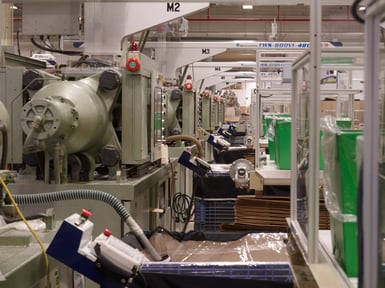 Plastic injection molding processes are fast, efficient, and precise when conducted by an experienced professional plastic molder using advanced, automated machinery. By using appropriately advanced equipment and automation technology, each manufactured piece will be identical to the initial design file and other units in the order.
Plastic injection molding processes are fast, efficient, and precise when conducted by an experienced professional plastic molder using advanced, automated machinery. By using appropriately advanced equipment and automation technology, each manufactured piece will be identical to the initial design file and other units in the order.
Automated injection molding equipment can ensure the same amount of material gets introduced to the mold each time, at the same pressure, in the same amount of time, along with dozens of other related variables. This blog post will take an in-depth look at the advantages and extensive applications of these systems.
Advantages of Automation and Robotics in Plastic Injection Molding
Automation is becoming increasingly prevalent throughout every type of manufacturing because automated systems can take on most aspects of the work without operator action. This results in:
- Better utilization of the machines. Automated systems are interconnected and communicate through a centralized control system. This type of injection molding equipment will generate analytics that allows users to identify opportunities for improvement and alert human operators when parts malfunction or need inspection.
- Faster production: Robotic systems can move through processes without interruption. Properly maintained automated systems would operate 24/7, resulting in better per-unit production and quick order completion.
- Reduced labor costs: Robotic systems can handle work that previously required multiple people, allowing facilities to take on more orders with fewer staff members. Lower direct labor costs and associated expense reductions ultimately result in lower overall project costs.
- More sustainable fabrication. Because automated machines create high volumes of products with low error rates, they generate less waste from rejected or deformed parts.
Traditional Injection Molding Vs. Automated Injection Molding
.png?width=300&name=Advantages%20of%20Automation%20in%20Plastic%20Injection%20Molding%20(1).png)
Introducing automation to injection molding processes has many benefits outside the direct molding process. One of the key differences between traditional injection molding and automated injection molding is the material handling component after the mold opens. Newly molded parts are fragile and vulnerable to deforming from pressure. Robotic systems with pneumatic grippers or vacuum-based collection systems can collect the workpiece without damaging or compromising it. Finely-tuned tools can also handle goods that need overmolding or further processing.
Applications for Automated Plastic Injection Molding
Automated plastic injection molding is useful throughout a wide variety of industries and applications. Common uses for automated processes include:
- Loading and unloading. The loading and unloading process for plastic injection molding machines uses a lot of space if left to manual processes. Robots can create an ideal working environment that efficiently operates in constrained areas and can load or unload the machines without the risk of human error. Automated machinery also uses the same amount of shot material per cycle, so the products are uniform and exact.
- Vision inspection and quality control. Humans can oversee inspection processes through the use of robotics and automation. Robots can orient the parts, use sensors to determine if there are any dimensional errors, and more.
- Assembly/sorting/stacking. Robotic systems can complete complex tasks after the mold stage. These tasks include welding to build assemblies, sorting and arranging parts for kits or packaging processes, and more. These capabilities further reduce the risk of error and speed up the order completion cycle.
- Secondary processes. Molded products often require secondary operations, such as decorating and labeling. Smart systems can employ side-entry injection molding robots to perform these tasks quickly and accurately.
Get High-Quality Plastic Injection Molding With The Rodon Group
Automation at Rodon assists with every stage of plastic injection molding to ensure the finished products adhere strictly to their design specifications. Automated equipment also makes the order quick, efficient, and cost-effective. Our facility has 125 presses, is fully automated, and with a full production schedule (24 hours, seven days a week) during most of the year to maximize efficiency. Each press is microprocessor-controlled and self-diagnostic, with capacities from fractional to 107 ounces, and clamping force from 46 to 720 tons. To learn more about our highly automated facility visit: https://www.rodongroup.com/facility or contact our team directly.








Comments